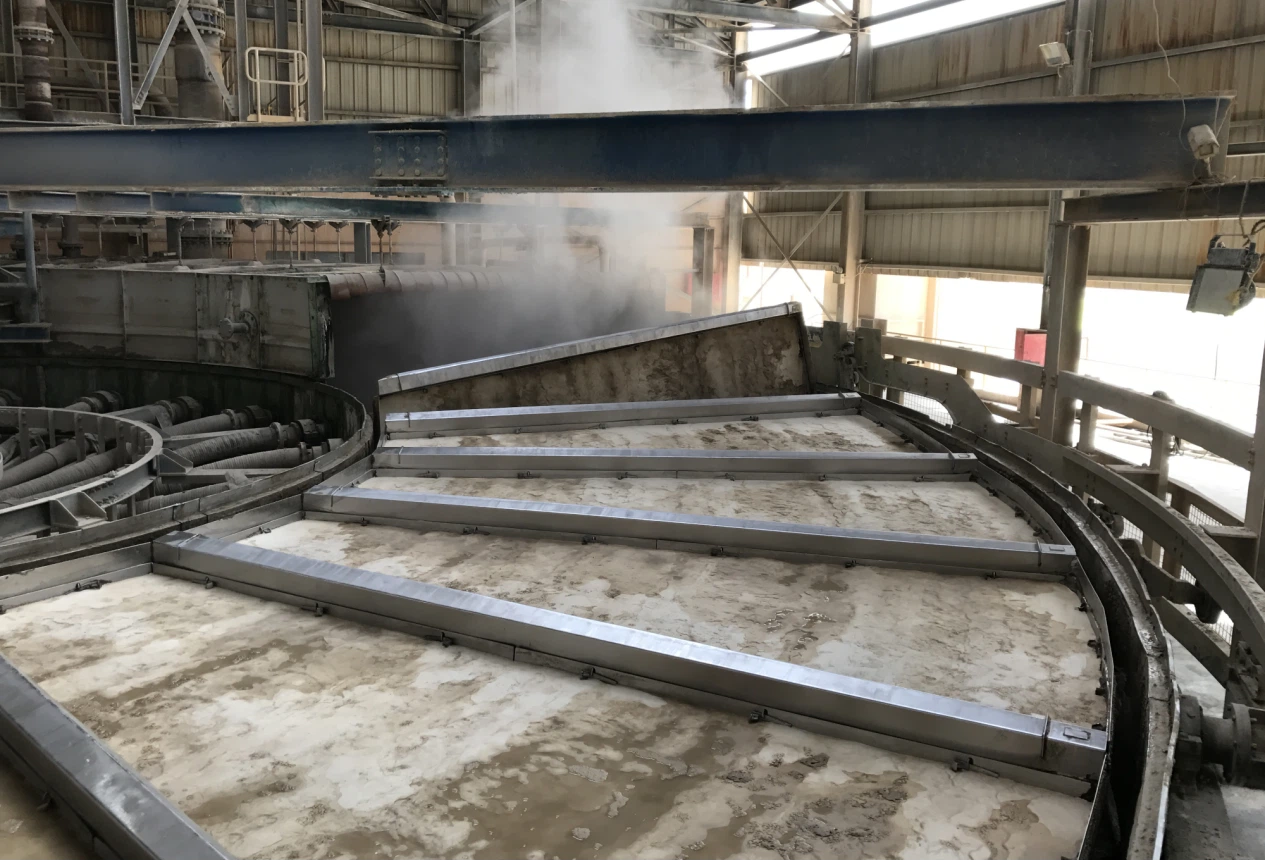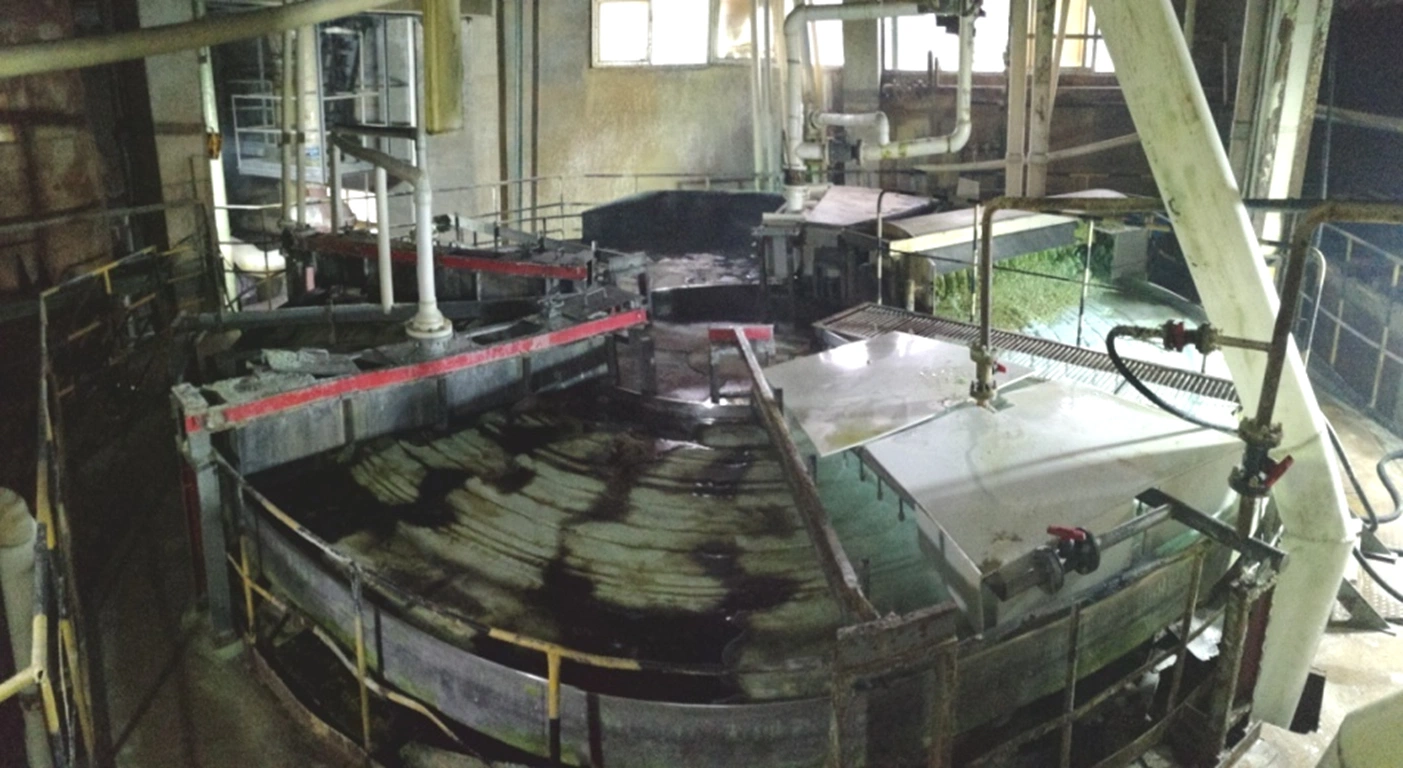Electric vehicles come off assembly lines quicker than before. Renewable energy storage setups expand to handle growing needs. At the center of lithium iron phosphate batteries sits high-purity ferrous sulfate. This main raw material mostly comes from the titanium dioxide field. Titanium dioxide making supplies a regular amount of this compound as a side product. But boosting titanium dioxide powder output relies on solid-liquid separation that works without stops. Good filtration keeps things going. Without it, holdups slow the whole thing down. Efficient filtration keeps production running smoothly. Pan vacuum filters handle solid-liquid separation in TiO₂ production, ensuring steady, reliable operation.

The Bottleneck of Traditional Filtration in TiO2 Industry
Traditional methods have hindered progress in titanium dioxide production. Factories face numerous challenges when using older filters. These problems accumulate, leading to decreased production line efficiency and increased costs. Let’s examine what exactly went wrong.
Limitations of Batch-Operation Centrifuges
Batch centrifuges can’t keep up in busy plants. They work in cycles. Start, spin, stop, empty. Repeat. This setup limits how much titanium dioxide powder a factory can make each day. For instance, a typical centrifuge might handle only 5 tons per batch. Then it needs downtime to unload. In titanium dioxide production, where slurry flows constantly from reactors, this stop-and-go hurts output.
Low Efficiency and High Labor Costs
Efficiency declines when machines require continuous maintenance. In titanium dioxide production, workers need to closely monitor centrifuges. They need to adjust speeds, inspect seals, and clean residues. These tasks are time-consuming and cause labor costs to accumulate rapidly. At $15 per person per hour, this can amount to thousands of dollars per month. Furthermore, human error is difficult to avoid. A single oversight can lead to poor separation, affecting the quality of the titanium dioxide powder. Rotary pan filters with automated systems cut labor and energy waste from old centrifuges, freeing workers, reducing errors, and lowering costs.
Production Instability Under Scale
As the demand for titanium dioxide powder increases, scaling up production often exposes underlying issues. Traditional filters perform well at smaller volumes, but they encounter difficulties when handling larger quantities. Centrifuges can become overloaded, leading to more frequent breakdowns. A single failure might stop the entire production line for several hours. So, in metallurgical equipment, maintaining stability is crucial for consistent performance.
Pan vacuum filters offer a reliable solution by scaling effectively without causing disruptions. This instability impacts the whole titanium dioxide production chain, from raw materials to the final powder. To progress, adopting rotary pan vacuum filters is essential, as they provide dependable performance regardless of the scale.
How Pan Vacuum Filters Fit in the TiO2 Process
Pan vacuum filters integrate smoothly into the titanium dioxide production process. They manage the slurry that comes from reaction tanks, where crystal FeSO4·7H2O appears in pulp form. Pumps deliver this material to the filter. As the pan rotates, the filtration occurs, followed by washing and dewatering. The result is a filter cake with exact moisture and TiO2 levels. A discharge screw takes away the cake, and conveyors move it to the next parts. This setup makes sure of a regular flow in chemical filtration equipment.
To understand their role, it helps to start with the fundamentals. Rotary pan filters use vacuum to pull liquid through the material, and they work well for ongoing tasks. In titanium dioxide production, this lets the process go on without halts. Now, let’s check the steps more closely.

The Filtration Stage
The slurry gets to the rotary vacuum filter, where the pan turns slowly. Vacuum draws the filtrate out, letting solids build up as a cake in the filtering area. The speed here directly shapes the quality of the titanium dioxide powder. From this stage, the process transitions naturally to washing. If filtration is ineffective, washing suffers as a result. Yet, with pan vacuum filters, everything connects seamlessly. The cake forms rapidly, which enhances the overall throughput in titanium dioxide production.
Washing and Dewatering Operations
After filtration, the washing phase starts with a counter-current wash using fresh water, followed by two co-current stages. This approach reduces moisture levels and minimizes surface TiO2. The wash liquor from later stages is recycled to earlier ones, collected in troughs, and reused for the initial wash. This efficient reuse conserves water and enhances metallurgical process performance.
Dewatering comes next, where vacuum extracts additional liquid, drying the cake to meet specifications, such as 15-20% moisture. Pan vacuum filters achieve this with precision, eliminating uncertainty. The shift to unloading proceeds without issues, and the system prepares itself for the next cycle.
Discharge and Regeneration
A three-headed screw discharges the ferrous sulfate cake. Any remaining particles are removed by reverse air blow, which mixes them back into fresh slurry for repulping. This process improves the filter cloth’s permeability, sometimes increasing it by up to 50%. Vacuum from the pumps travels through disks and headers, with gas-liquid separators managing the mixture before storage. The cycle continues without pause. Rotary pan filters maintain ongoing operation, providing a consistent supply of high-purity byproducts in titanium dioxide production.
How NHD Pan Vacuum Filters Enable True Continuous Production
NHD ranks among the leading rotary vacuum filter manufacturers. Their pan vacuum filters deliver substantial benefits to titanium dioxide production through innovative features that support non-stop performance. Automation plays a key role, while stability remains strong even under demanding conditions. Let’s explore what distinguishes them.
The Ingenious Design for Non-Stop Operation
NHD’s design emphasizes reliable and smooth functioning. Large diameter drive pinions minimize bending moments, enhancing overall rigidity and ensuring steady operation. An external drive reduces torque, which lowers power consumption by about 50% compared to internal drives. In titanium dioxide production, these savings contribute meaningfully to cost control.
Floating support structures accommodate thermal expansion, and patented technology prevents flatness problems caused by temperature variations. As a result, filter pans remain level without warping. This design allows continuous production to proceed without obstacles, making NHD’s rotary pan filters stand out in the field.
Automated Operation and Labor Reduction
PLC systems oversee all aspects of the operation, with sensors tracking vacuum levels and adjusting speeds as needed. This reduces the requirement for constant manual intervention, potentially cutting labor needs by 40%. Workers can monitor from control rooms, which also improves safety in chemical filtration equipment.
Such automation guarantees consistent output of titanium dioxide powder, with fewer mistakes and greater uptime. These elements form a solid foundation that leads into the stability advantages.
Unmatched Stability for Massive Throughput
NHD filters operate around the clock, seven days a week, without requiring breaks. In metallurgical equipment, this level of reliability is highly valued. Patented features in the drive and support systems enable this performance, leading to uptime rates of 95% or higher. Together, these attributes facilitate genuine continuous production. NHD’s rotary vacuum filters redefine efficiency standards in titanium dioxide production.
Proven Cases in Titanium Dioxide Production
More than 160 sets of NHD pan vacuum filters are in use globally. The largest example is a 45m² unit dedicated to titanium dioxide production. Their applications extend to metallurgy, environmental protection, ore washing, and paper making. These real-world implementations confirm their effectiveness. Below are some notable examples.
45m² Pan Vacuum Filter for Shandong Jinhai Titanium
This unit manages high volumes in titanium dioxide production. Installed in 2018, it processes 150 tons daily while keeping cake moisture below 18%. Energy savings reach 45%, and the plant enjoys smoother operations with no significant downtimes over the years.

25m2 Pan Vacuum Filter for Xuzhou Titanium White
In Xuzhou, the setup prioritizes precision. The 25m² filter processes finer slurries of titanium dioxide powder, achieving an output of 80 tons per day. Its washing efficiency reduces TiO2 loss by 25%.
img.25m2 Pan Vacuum Filter for Xuzhou Titanium White.webp
25m2 Pan Vacuum Filter for Longbai Sichuan Titanium Industry
In Sichuan, the filter blends well with existing production lines. It operates continuously for titanium dioxide production, handling 85 tons daily. Maintenance is needed only every six months, resulting in 30% savings on parts costs.

These cases showcase how NHD’s rotary vacuum filters perform in practical environments, driving efficiency improvements across operations.
Calculate the Long-Term ROI of Your Filtration Upgrade
Switching to pan vacuum filters yields returns over the long term. It’s important to consider more than just the initial expense; the true benefits emerge from ongoing efficiencies. Let’s examine the numbers in detail.
- Focus on TCO Rather Than Initial Investment
Total cost of ownership encompasses all expenses involved. A new rotary vacuum filter may have an upfront price of $500,000, but over five years, the savings accumulate. For example, energy costs could decrease by $100,000 annually, and maintenance expenses might be halved compared to older centrifuges.
In titanium dioxide production, evaluating TCO provides a clearer picture. While the starting investment appears substantial, the payback period typically falls between 18 and 24 months.
- Gains from Increased Output and Lower Downtime
Production capacity can rise by 25% with continuous filters. Consider a plant producing 50,000 tons of titanium dioxide powder each year; an upgrade could add 12,500 tons, generating an extra $12.5 million in revenue at $1,000 per ton.
Additionally, downtime reduces from 10% to 2%, saving approximately 29 days of production annually. In metallurgical equipment, this enhanced stability directly boosts profitability.
- The Tangible Savings on Maintenance and Labor
Maintenance expenses drop by 40%, as components endure longer. Labor requirements might decrease from 15 workers to 5 per filtration line, leading to annual savings of $150,000 in wages.
Conclusion
In the competitive global titanium dioxide market, achieving scalable and cost-effective production is essential. Rotary pan filters address these demands by enabling continuous solid-liquid separation, improving efficiency, and reducing expenses. As the need for titanium dioxide powder continues to grow, these machines become indispensable.
For professionals in titanium dioxide production, NHD‘s solutions are worth exploring. Our rotary pan vacuum filter is designed for such applications. And we can provide personalized guidance, which can significantly improve your operations. Contact us today at [email protected] to discover how pan vacuum filters can meet your specific requirements.

